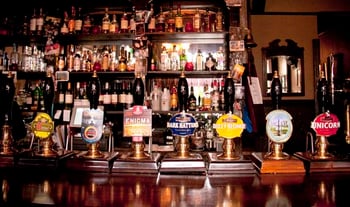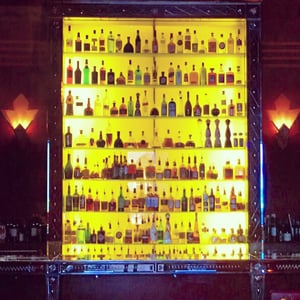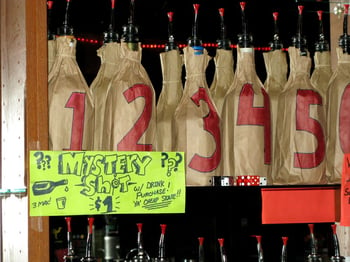Do you know the exact number of products carried at your bar? If you do, consider yourself in the minority of people who are on top of this often neglected, yet important aspect of your business.
Many bar owners and managers don’t know how many products they carry which isn’t an ideal way to run a business. Hopefully there is a considerable amount of thought placed into which specific products are offered to your customers and knowing how many you have is an important start.
 At Bar-i, we have a unique perspective about this aspect of the bar business. We currently complete over 100 detailed bar audits every month across 11 states. We work with many different types of bars and have seen a wide range of examples of what works and what doesn’t work. This perspective has played a major role in shaping our philosophy regarding the most effective ways to address product selection.
At Bar-i, we have a unique perspective about this aspect of the bar business. We currently complete over 100 detailed bar audits every month across 11 states. We work with many different types of bars and have seen a wide range of examples of what works and what doesn’t work. This perspective has played a major role in shaping our philosophy regarding the most effective ways to address product selection.
In most instances, we find that the bars we work with have a product selection that is too large and as a result, it ends up reducing their profits. Carrying a bloated product selection can impact your profitability in the following ways:
- Cannibalizing sales – When product selection is too large, you will often be forced to discount products that don’t sell well in order to use them up. This isn’t the right reason to offer discounts and over time, it can seriously eat into your profit margin.
- Wasting time – When you have a very large product selection, it becomes more complicated to track your inventory and in general, it takes more time to do just about everything, including stocking the bar, performing inventory, and handling your ordering. Instead, your managers should be making use of this time by working on tasks that will help improve the efficiency and profitability of your bar.
It’s time that you take a hard look at your product selection and make sure these decisions are being guided by profitability considerations. Ultimately, this is the most effective way to leverage your selection in a way that contributes to the success of your bar.
Why Is it Important to Set Hard Product Selection Guidelines?
There are many reasons why you should consider setting hard product selection guidelines at your bar. These include:
There is an inevitable tendency for product selection to grow over time.
There are several factors which contribute to this inevitable expansion of product selection over time, and it will take a concerted effort on your part to prevent this growth:
- Choosing new products and tasting new products is one of the more interesting and exciting aspects of running a bar. As you engage in this process, you are usually going to find at least a few new products that you really like and want to carry.
- You regularly interact with sales reps who are trying to get their products into your bar.
- New products are constantly being created and the manufacturers are setting sales targets for their reps to get these new products placed in bars.
It becomes more challenging to maintain the simplicity of your operations when you have a massive product selection.
The more products you add, the more complicated the process of ordering, checking in products, and setting up your POS system becomes. In general, most bars don’t do a great job at checking in their invoices (all invoices should always be checked line by line to ensure everything was delivered properly).
Similarly, many bars don’t do the best job keeping up with their POS, and new products that get added on the fly don’t always make it into the POS system. When your POS isn’t properly updated, it can significantly eat into your profit margin over time.
When you have more products, you lack emphasis in any one area.
 If you have a smaller selection of whiskeys, then choosing between these options will be less overwhelming for your customers and might encourage them to become familiar with more of the products you offer since it will be easier to navigate the menu.
If you have a smaller selection of whiskeys, then choosing between these options will be less overwhelming for your customers and might encourage them to become familiar with more of the products you offer since it will be easier to navigate the menu.
In addition, a massive selection of whiskeys (or any other type of liquor) often results in a situation where certain bottles simply don’t sell well. When you carry a smaller selection, you can focus on the products that appeal more to the tastes of your customers.
Sales reps are offering incentives to your managers to carry their products.
Always keep in mind that distributors are actively trying to get their sales reps to increase their product placements. You need to be careful that your manager in charge of ordering is focusing on what’s best for your business, not what’s best for your distributors. While it’s great for your ordering manager to maximize the perks offered by sales reps, this won’t necessarily contribute to improving your bar’s profitability.
Unless you have a solid plan in place, it will be a struggle to maintain a manageable product selection due to the conflict of interest created when your ordering manager is presented with incentives to order more products from these sales reps.
When you have more products, you begin to lose your leverage in securing better prices from your distributors.
Eventually, you hit a point of diminishing margin of returns where you’re no longer increasing the overall sales volume for each product. Instead, you’re actually creating a situation where your sales volume for each specific product carried goes down.
By scaling back your product selection, you can do a larger sales volume for each product. If you’re organized, you can calculate your long term usage for each product, and this will allow you to negotiate better prices from your distributors since you’ll know exactly how much of a product you’ll need over a 3-6 month time period.
Server product knowledge suffers when your selection is too large.
 You only have a finite amount of time to dedicate to training your staff. The more products you carry, the less depth of knowledge your staff will have about each specific product.
You only have a finite amount of time to dedicate to training your staff. The more products you carry, the less depth of knowledge your staff will have about each specific product.
It’s better to have a smaller number of products that all your servers can talk intelligently about than a larger number of products that your servers have significantly less knowledge of. This lack of knowledge results in providing poorer service to your customers, and it becomes more challenging for your servers to upsell high end products to people who are interested in these items.
If you want greater variety, consider establishing a rotating selection so that your products only change every few months. By keeping a smaller number of products on hand for a set period of time, your servers will have a greater ability to learn about each new wave of products as they get added to your selection.
After a certain point, a larger product selection isn’t going to increase your profits.
If a larger product selection isn’t improving profitability, then it’s not really helping your bar. You’re better off rotating your selection seasonally as we mentioned above in order to achieve the variety you seek. We recommend rotating products every six months, but some high end establishments may want to consider a three month rotation schedule.
It’s also important to remember that every time you change your products, you create transaction costs such as the time spent updating your POS system and the time spent training your staff on the new products being offered. These transaction costs can take up a lot of time, bogging down your staff and preventing them from focusing on more important aspects of running your bar. Therefore, it's best to keep these transaction costs minimized by only changing your product selection once in a while.
Tips for Reducing Your Product Selection to a Manageable Level
Take a few minutes to think about what’s optimal for your bar. Then set a hard limit on the number of products you’re willing to carry. We typically recommend that our clients set this hard limit at 150-200 total products. Your limit should be a specific number, not this entire range. You can determine whether you want the limit to be closer to 150 or 200 based on the specifics of your business model.
Compare this new limit to your current product selection and set a schedule to hit your new target. You’re much more likely to be successful in achieving your goals if you set a timeframe for hitting them. If you currently carry 250 products, consider setting a goal of cutting this number to 200 within the next three months.
Next you need to create a concrete plan to achieve your new target number of products. We recommend the following plan to the bars we work with:
- Implement a freeze on new product orders. This must be strictly adhered to if the freeze is going to work. No exceptions.
- Refuse all items you didn’t order unless they are genuinely free.
- Get rid of promotional products that never caught on with your customers. You can take some of these items home for “research and development.” Getting these products out of your bar will reduce clutter and help you get to your target goal.
- If some of these rarely used promotional items are straight spirits (i.e. no weird flavors), you can use them as your well products. This will allow you to sell these unwanted products and get them out of your bar so that you can focus on only carrying the products that are driving profits.
- Discount items that aren’t selling well. While this cannibalizes your sales and shouldn’t be considered a long term strategy, it can be an effective short term strategy to help you get rid of unwanted products so that you can reach your target product selection goals. Some good ways to approach this include offering a mystery shot (more on how to do this below) or by using promotional products in specialty drinks. You can create urgency by telling customers to “get this special drink while you can” since the drink will only be offered while supplies last.
- Quarantine extra products and only use a few at a time. If you really have a lot of extra products that aren’t selling, take them all and put them in a specific place in the bar, such as the office or a special shelf in your storeroom. Then bring out a few bottles at a time and create ways to sell them, such as a specialty drink or mystery shot. This will make the process of getting rid of these unwanted products more manageable.
Creating “Mystery Shots” to Get Rid of Extra Products that Aren’t Selling
 As we mentioned earlier, a great way to get rid of extra products that haven’t been popular with your customers is to create a “mystery shot.” We recommend turning this into a dice game that will create intrigue for your customers, making it a little more fun for them to drink these products.
As we mentioned earlier, a great way to get rid of extra products that haven’t been popular with your customers is to create a “mystery shot.” We recommend turning this into a dice game that will create intrigue for your customers, making it a little more fun for them to drink these products.
Take 6 products at a time that you want to use up. Place each bottle in a brown paper bag and number the bags from 1-6. Customers can roll the dice and receive a shot of the mystery bottle in the bag with the same number that was rolled on the dice.
By turning this into a game, you are more likely to sell these unwanted products much quicker. You also might want to consider pricing the mystery shot in a way that creates additional value for your customers since this might entice them to play the game.
Continually Review Performance to Optimize Your Product Selection
Once you’ve gotten your product selection under the hard limit, you can start evaluating the performance of the remaining products you offer. To do this effectively, you’ll need to maintain the hard freeze on new products for a set period of time so that you can evaluate which items sell well and which items aren’t popular with your customers. We recommend a 6 month time frame to review the performance of your products before rotating any of your selection.
As you reach the end of this time period, evaluate the performance of every product critically to determine which ones should stay in the rotation and which should be replaced with new products for the next time period. This process will help you get organized for negotiations with your distributors.
We recommend that you establish a bidding process between your distributors in order to leverage the best possible deals on the new items that replace the poorly performing items you will no longer carry. To get the best outcome:
- Have hard numbers to use in negotiations. This will make it more challenging for your sales reps to pressure you into purchasing unwanted products that don’t help your profitability.
- Set up meetings with reps. Come to these meetings with a plan. You’re looking to add 2 new cabernets, 3 new vodkas, and 2 new bourbons. This plan will ensure you stay focused on the specific items you need to add.
- Make a decision and stick to it. Figure out which distributors are giving you the best deals on the new products you want to add and then act decisively. The goal is to keep this process streamlined and simple so that you can move on to dealing with other aspects of running the business.
This process will allow you focus the majority of your energy on the elements of your business that make you more money, such as staff training, strategies to increase check averages and server upselling.
Bar-i Can Help with Product Selection Issues
Bar-i’s software has the ability to evaluate product selection issues on a deeper level. Our dedicated account managers can provide you with assistance and consulting that will help you more effectively manage your product selection. This is just one of the many ways we can help you maximize your profits.
Keep in mind that our highest volume client who regularly does $100,000 in bar sales every week only carries 200 products. We’ve seen first-hand that you don’t need more products to generate larger sales volume. You just need an effective strategy for how to sell the products you currently carry. Bar-i can help you develop and implement this strategy.
To learn more about how Bar-i can help you maximize profits and improve your bar’s performance, please contact us today to schedule your free consultation. We serve clients nationwide from our offices in Denver, Colorado.


-1.png)